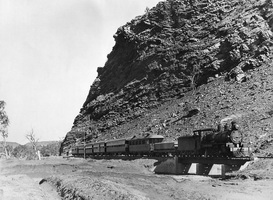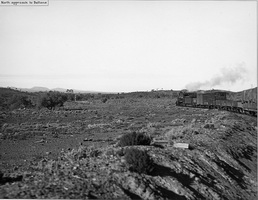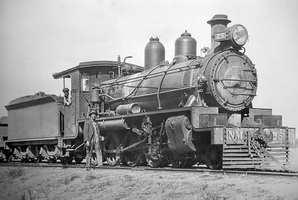
Many stories about railways have featured robbery and theft. Western movies regularly had trains robbed and Britain had its great train robbery, yet here in Australia rarely is the topic ever mentioned. Could it be that we haven't had train robberies, or is it that they were not the stuff of great novels or film scripts and so just got forgotten? Research has led me to the story that follows and suggests that in fact many such robberies have occurred, some of which could be, from the thief's point of view, be considered very successful.
The Great Northern line of the Commonwealth Railways (CR) or Central Australia Railway (CAR) had several thefts over the years. In July 1928, before the Oodnadatta to Alice Springs line had been completed, a large sum, totalling £3,100 ($6,200) in money and bank notes, was stolen from the brakevan of a train at 61-mile camp north of Oodnadatta. Six hundred men were at that time employed on the construction project and by using an Aboriginal tracker the authorities were able to arrest and convict two men. All the money was recovered, some of which had been buried in a rabbit burrow, the rest being hung in oatmeal bags from trees.
Another incident involved interference with the mail on a train at Hammond (Peterborough to Quorn section) in 1934. The stolen goods were subsequently found buried in three different places along the track. But the main story I wish to tell here occurred the following year when the recovery of money and conviction of felons was not so successful.

The narrow gauge Ghan was one of those legendary trains that seems to be mentioned anytime a conversation turns to "Australian Rail Adventures". A lot of history, legend, tall stories and facts of dubious origin abound. Some stories even wander from one location to another, reappearing in various forms at various times, with a wide variety of characters interacting in unusual circumstances to generally produce a comical result. Tales of washaways, delays, wrecked bridges, slow trains and the ups and downs of the Pedirka sandhills abound, yet strangely enough the loss of 34lb of gold in 1935 seems to have been forgotten rather than immortalised in contemporary folklaw. Perhaps no one liked to talk about it because of the embarrassment, or it may have just not have seemed worth remembering at the time. The Great Ghan Gold Robbery occurred sometime between 8am on Tuesday 28 May and Thursday 30th May 1935 on the lonely stretch of railway linking Alice Springs with Quorn. A registered mail bag containing a parcel of gold ingots, weighting 34lb (15.4Kg) and valued at £4,000, disappeared from a safe in the brakevan of the "Express". The "Express" was short for "Northern Express" which was the official name used for the Limited Mixed service that was locally known as "The Ghan". At the time of the robbery the train was returning to Port Augusta from Alice Springs with the gold locked in the train safe, in the brakevan (Commonwealth Railway brakevans were never referred to as "guard vans"). On arrival at Quorn the gold was found to be missing.

Immediately the newspapers started speculating. Who could have done it? How was it done? Where? When? How did the thieves get away unnoticed? Showing their usual flair for making up a good story, the papers reported the incident extensively. Sensationalism and instant experts on any subject were the order of the day. Some reporters even managed to locate a photograph of Marree station to dazzle their reader about this mysterious remote location.
The major portion of the gold consignment was from the Tennant Creek Granites, Tanami and Winneke mines and had been delivered to Alice Springs by Motor Car the previous Sunday. An escort of two armed miners had accompanied it. The gold, in a consignment of unmarked registered mail, had been handed to the guard by the Alice Springs Stationmaster 10 minutes before the "Express" departed. Despite a consignment note that said nothing other than general registered mail, the guard guessed that the package may have been important, due to its weight, and so carefully placed the package in the safe along with the rest of the registered mail. Upon locking the safe, in the presence of the Stationmaster, he place the key in the pocket of his tunic, were it was alleged to have stayed until the train reached Quorn. Sending gold by unmarked registered mail had up until this time been standard practice despite the railway Commissioner expressing some concern to the Post Master Generals Office about the prospect of theft. The Post Office was not greatly concerned, replying that as their liability was limited £50 ($100) in the event of any register parcel going missing, it was the consigners concern. Naturally nothing was done to improve the situation.
Most train services between Alice Springs and Quorn were operated by two crews, who worked in relay fashion, with guards swapping shift at Rumbalara, Pedirka, Warrina, Beresford, Marree and Parachilna. When not on duty each member of crew would retire to his sleeping quarters located in a composite relay brakevan. A feature of the working of this particular train was that at no stage was the key passed between guards, it stayed in one guards possession, even when off duty, until being passed to the Stationmaster at Quorn. This unofficial practice seems to have been adopted to save time on paper work as the safe would not normally need to be opened whilst in transit. During the journey nothing unusual happened, everything seemed to have gone normally until arrival at Quorn. For a service that was notorious for its washaways, derailments and work practices, it is hard to imagine what might have been considered unusual. Sometimes, unjustly, the Commonwealth Railways earned the public's scorn and were cruelly referred to as the "Comical Railways".
The safe was open in the presence of the Guard by the Booking Clerk Quorn, who found the door a little stiff and the gold missing. It's not hard to imagine the reaction when the Stationmaster dispatched the following message, by telegram, to CR Commissioner Mr. Gahan in the Melbourne Head Office.

"Mailbag containing bullion reported to be considerable value stated placed in Brakevan Alice Springs No.4 Tuesday, not in safe when opened by booking clerk in presence of Guard immediately on arrival at Quorn this morning."
Two detectives were dispatched by motor car from Adelaide that day. On arrival at Quorn they would finger print the safe, interview witnesses and travel along the line by section car looking for any sign of the missing consignment. Assistance was provided by the railways wherever possible. Staff and section cars were made available.
The papers loved the episode and highlighted it with headlines like "Gold Stolen - Safe in train Rifled", "Mail Train Mystery - Parcel taken from Safe", "£4,000 Gold Robbery from Train - Missing between Alice Springs and Quorn - Baffling Case". Stories abounded, as speculation ran rife. The "Adelaide Advertiser" had the following to say on 31.5.1935.
"The type of safe used on the train is very old. It is not large, and has an ordinary old style lock. There is no combination, and it is thought it would be an easy matter for anyone of make a duplicate key. It was stated tonight that in competent hands the safe could easily be opened with a piece of wire. Articles of considerable value are carried on the train both ways.The view is held here that the work is that of someone with an inside knowledge of the railways. The safe was in perfect order when the train reached Quorn except that the door was a little stiff.
The safe is thought to have been robbed while the train was at a siding and when the guard was assisting in shunting. The other guard would then be off duty resting.
The theory was advanced tonight that a thief might even have taken the key (a bulky one with a brass tag) from the tunic of the guard on duty, as often before shunting, the guard removes his tunic and hangs it in the van."
The Police Investigation had only just begun, yet the Advertiser had most of the basic facts of the case worked out, and the crime almost solved, except for the minor detail of who actually did it. Subsequent official reports suggest that the safe could not have been picked, and that a duplicate, not the guards key was used. A follow up story even mentioned a mysterious man who was being hunted by police, despite the lack of official reports ever having mentioned him.
"Port Augusta May 31, Police investigating the £4,000 gold robbery from the Alice Springs-Quorn passenger train were not able to advance much further in their investigations today. However, it was reported tonight that they were searching for a man who came here by train from Quorn tonight."

Reporting got so out of hand that Commissioner Gahan felt compelled to set the story straight. He issued a statement that the makers certificate for the safe claimed that the lock could not be picked, and it seemed evident that a duplicate key had been used. Coverage continued with the Courier Mail having the following to say on 1.6.1935
"According to information received by the Commonwealth Commissioner of Railways (Mr G.A.Gahan) the theft of a parcel of gold, valued at between £3000 and £4000, from the Commonwealth train between Alice Springs and Quorn (South Australia) was not due to the key of the safe having left the possession of the guard, but to the use of a duplicate key.Mr Gahan revealed to-day that in another carriage on the same train from which the gold was looted there was a railway pay roll of £2500 left untouched. This money was in a safe guarded by an armed pay clerk."
While the papers continued the investigation, the detectives got on with the real work and interviewed many people, but were unable to come to any conclusion as to where and when the mail bags were stolen. Most probable location for the theft was thought to be Oodnadatta, Abminga or Edwards Creek, each of which were passed through in darkness when the guard was occupied for 30 minutes, 70 minutes and 38 minutes respectively. Nothing more conclusive was discovered by the initial investigation so a reward of £250 ($500) was posted by the insurer. This was later raised to £500 ($1000), but never collected, eventually being withdrawn after it became obvious that no one was going to come forward and claim it. As for the missing gold, it was never recovered and to this day the people who know what really happened are not telling. The bad guys got away, with the authorities none the wiser to how or who.
In true railway fashion, someone had to be found to accept some of the blame, even though legally the railways could not be held responsible. They had never officially been notified of the gold consignment. Obvious choice for scape-goats were the two guards. As some petty offenses against working instructions had occurred during the journey, and probability every journey before, the CR took disciplinary action. The first guard was fined 10 shillings for
"carelessness in respect of one value package of mail placed in the brakevan of safe No.4 Mixed at Alice Springs in your presence on the 28th May 1935 for conveyance therein to Quorn in as much as on the 28th and 29th May 1935:-1)When being relieved of the duties of guard of No.4 Mixed train you failed to hand over the key of the brakevan safe to the Guard who relieved you, and to obtain his receipt for it, in accordance with Clause 110, page 224 of the General Appendix"

The second guard was fined 15 shillings for similar offenses. The additional amount was due to him leaving two Y wagons consigned to Port Augusta and Port Adelaide at Oodnadatta by mistake on an earlier trip.
The Northern Express that contained the gold shipment movements provides an interesting insight into train operations on the Central Australia Railway. The train consisted of an NM engine hauling freight wagons, with two sleeping cars, one sit-up car, dining car and brakevan. It is hard to imagine the train paying its way as at no time did the train have more than 7 fare paying situp passengers. Employees on staff passes peaked at 16 giving a grand maximum total of 19 situp passengers on the train between Marree and Quorn, plus a small number of passengers in the sleeping cars. The quietest part of the journey was between Alice Springs and Pedirka when only seven situp passengers, paying and staff passes, were on board the train. If this is the best they could do it suggests that perhaps Community Service Obligations (CSO) are not only restricted to the modern operations of Australian National as on train staff totalled 10, consisting off two sleeping car porters, two dining car staff, and two relay crews of guard, driver and fireman.
The next time you swap train stories with someone tell them about "The Great Ghan Gold Robbery" and perhaps dream of finding the gold buried somewhere along the line. Nobody can say your wrong, because anyone who really knows what happened is not telling.